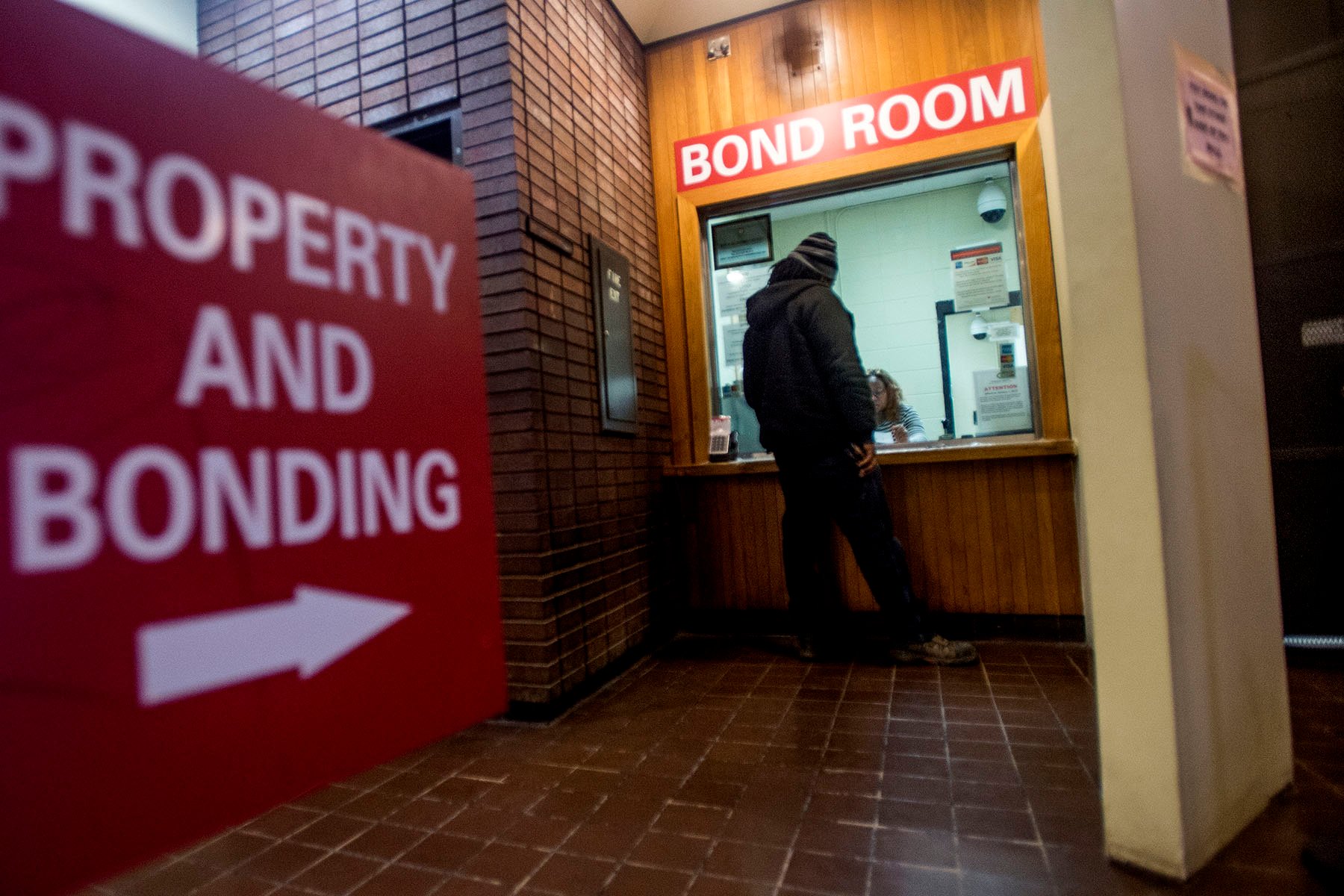
In 2015, a pregnant and homeless 30-year-old woman spent 135 days in an Illinois jail because she stole two plums and three candy bars from a Save A Lot store.
That same year, a 41-year-old Illinois woman, who was later determined to have a mental illness, spent 112 days in jail for “criminal trespassing” — smoking a cigarette on the steps of a vacant mobile home.
These kinds of stories, recorded on the Cook County Sheriff’s Office blog, are common throughout the United States. Women and LGBTQ+ people who encounter law enforcement while experiencing poverty, health crises or gender-based violence are often trapped behind bars for days without a criminal conviction because they cannot pay their pretrial bail.
In 2021, Illinois decided to make a change and became the first state to eliminate the use of cash bail through the Pretrial Fairness Act. As of September 2023, Illinois courts use risk assessment tools to determine a person’s potential threat to public safety before releasing them pretrial, rather than basing the release on the person’s ability to pay.
Bail reform in Illinois is part of a larger movement over the past decade that called attention to racial bias to the justice system. That momentum is now in jeopardy as conservatives target bail reform and other measures that aim to reduce incarceration and strict criminal penalties.
In August, President Donald Trump signed two executive orders threatening to withhold federal funding from states and localities that significantly reduce the use of cash bail. In September, Republican Rep. Elise Stefanik of New York and Republican Sen. Marsha Blackburn of Tennessee also introduced bills in Congress to reinstate money bail in Washington, D.C., where the practice ended in 1992.
Republicans often argue that they want to crack down on crime and protect women, even as government data indicates significant declines in violent crime over the last 30 years. But advocates working on bail reform around the country argue that these policies benefit women on multiple levels, from those accused of crimes to survivors of gender-based violence.
How cash bail traps low-income women into poverty
The cash bail system highlights the inequities driving women to jails, which has long-term effects for them and their families.
Women held without a conviction represent 60 percent of the country’s local jail population, and 80 percent of women in jails are mothers, according to analysis by the Prison Policy Initiative. Most of these women live below the federal poverty line, and 53 percent of them were jobless in the 30 days prior to their incarceration, based on the most recent government report, published in 2023 but capturing figures from 2016. This is compared to 38 percent of incarcerated men who were jobless in the weeks before they were taken into custody.
The loss of household income due to prolonged incarceration after an arrest, and the absence of a child’s primary caregiver further destabilizes low-income households both financially and emotionally.
A defendant in jail pretrial typically has the option to pay their full bail amount, which can range from $5,000 for forgery to $1 million for a murder charge. This money is to be returned to the defendant after all of their court requirements have been met.
In most cases, however, people cannot afford the full bail. Instead, they use a third-party bail bonds business that pays for their bail in exchange for a non-refundable fee of 10 percent of the bail total. That 10 percent fee could still be $500, $1,000 or more, and therefore out of reach to most low-income women. As a result, they are left in a state of limbo until they are either convicted of their charges or set free.
Families spend an average of nearly $4,200 per year supporting an incarcerated loved one, and they lose an estimated average of $1,800 in monthly income, according to a 2025 report published by the advocacy nonprofit FWD.us. Children of incarcerated parents also are more likely to experience depression, anxiety and behavioral challenges.
“My children was my biggest concern while I was in jail,” said Andrea, a Black mother in Kentucky whose story was shared publicly by The Bail Project, an organization that provides financial assistance to people who cannot pay their bail. Andrea, whose last name the nonprofit withheld to preserve her privacy, was a single mother of six while in jail for 12 days.
“I seen, in my five-year-old Paris, when I got out of jail like it was a separation problem. Like I would go to the bathroom and she would cry. And she would be like, ‘Are you going to leave me again?’” Andrea continued. “My son Dante, he has ADHD already, so he goes through the emotional ups and downs. The whole 12 days I was locked up, he cried. And he didn’t want to go to school, he was depressed.”
Advocates supporting bail reform argue that changing this system has ripple effects for entire communities.
“One thing about bail reform is that generally people are released with some sort of conditions that are non-monetary, whether it’s completing substance use and abuse programs, or parenting classes or some sort of community service,” said Surraya Johnson, director of the Criminal Justice Reform Program at the New Jersey Institute for Social Justice, which was a lead advocate for the state’s 2014 law scaling back the use of cash bail.
“So they’re able to improve their communities in that way. And they also have the ability to remain employed and to continue to contribute to their families financially, and can continue to provide stable homes for themselves and their children and any other generations that may be living with them.”
What cash bail means for survivors of gender-based violence
Prior to Illinois’ bail reform law, those accused of domestic and gender-based violence could be released from jail if they paid. Meanwhile, survivors received little to no information about the status of their case, or even whether their abuser was back on the streets. This could have deadly consequences.
Survivors are also criminalized for defending themselves during intimate partner violence. Researchers at Stanford University surveyed 650 women serving sentences for murder and manslaughter in two California prisons and found that nearly two-thirds experienced intimate partner violence in the year leading up to their offense.
Illinois’ Pretrial Fairness Act has moved to change this by promoting more safety and less criminalization for survivors, said Amanda Pyron, president and CEO of The Network: Advocating Against Domestic Violence. Organizations supporting survivors of gender-based violence tend to operate in silos, without direct collaboration with criminal legal reform work. But advocates in both spaces partnered together to support Illinois’ bail reform law.
“I think that my experience inside the anti gender-based violence field for 30-40 years, is that it is a community full of people who are profoundly critical of the current criminal status quo and who are profoundly more attuned to the realities and problems of systemic racism,” said Kaethe Morris Hoffer, executive director of the Chicago Alliance Against Sexual Exploitation (CAASE).
Survivor support groups, including The Network, campaigned for bail reform by making television appearances, hosting town halls and writing opinion articles for local news outlets championing the bill. The Network also organized a team of domestic violence and sexual violence service providers who reviewed the legislation as it developed and evolved, Pyron said.
The law now requires prosecutors to notify crime victims of a defendant’s release from jail, their pretrial hearing and other stages of the case. It also established a process for pretrial release evaluations that involves lengthier, more detailed hearings instead of the standard bail hearings that may last a few minutes. Today, pretrial service officers interview defendants and analyze their criminal records, mental health history and community connections. The officers then put together a report with recommendations that a judge uses to consider release from jail.
The aim is to hold people accused of the most serious offenses and those who pose threat to public safety, and to release individuals charged with lower-level crimes or who are victims of violence.
“Having a risk-based system allows for prosecutors and defense attorneys and judges to prepare better for hearings,” Pyron said. “The prosecutors gather more information before hearing. That’s why they take longer. And defense attorneys are able to do a more robust information-gathering process, and so they’re able to make a case for a criminalized survivor at the first detention hearing that they don’t need to be incarcerated. They’re not a danger to anyone else.”
What data says about how bail reform affects crime and public safety
Trump and conservative lawmakers have condemned bail reform as a threat to public safety. One of the White House executive orders signed on August 25 states that “when these individuals are released without bail under city or State policies, they are permitted — even encouraged — to further endanger law-abiding, hard-working Americans because they know our laws will not be enforced.”
But preliminary research on the effects of reducing or eliminating cash bail suggests that these claims are wrong.
“You see a lot of language in the public statements that the president is using. That is language that’s been used by the private bail bond industry over the years,” said Erin George, national director of policy at The Bail Project.
“In addition to it being about political control, there’s a desire to protect a predatory private bail bond industry and distract from real public safety solutions,” George said.
Overall, cities and states with bail reform see declines in the rate of people being detained in jail pretrial, but that does not appear to cause notable increases in violent crime rates. Generally, crime data is complex to analyze because of different reporting standards depending on the jurisdiction, partial or missing data in the reporting and biases within law enforcement agencies.
A report looking at New Jersey’s 2014 bail reform law found that in 2012, 12 percent of the jail population consisted of “low-risk defendants,” compared with 4.6 percent in 2018 and 2.4 percent in 2019. The total jail populations from 2012 to 2018 decreased by about 43 percent. Meanwhile, the number of defendants who were charged with new “indictable” criminal activity after pretrial release remained steady at 14 percent in 2017, 2018 and 2019.
Another analysis by the Council on Criminal Justice focused on Chicago found that between 2023 and 2024, instances of crime did increase in certain categories, such as burglary and shoplifting. Violent crime categories like aggravated assault, domestic violence and homicides largely remained consistent between 2023 and 2024.
While these numbers compare the entire year of 2023 to the entire year of 2024, Illinois’ bail reform only went into effect during the last quarter of 2023. Looking at the first half of 2025, however, Chicago has seen a 33 percent decline in violent crime rates.
When it comes to the safety for survivors of gender-based violence, an analysis by local news outlet WBEZ found that more defendants accused of domestic violence have been detained pretrial in the year following Illinois’ bail reform law. Another study looking at bail reform in New Jersey found that, though the state’s law led to a decline in incarceration numbers, researchers found no significant change in rates of fatal violence against women.
George argued that political leaders do more to jeopardize public safety by pushing to cut funding to Medicaid, services for domestic violence survivors and organizations focused on crime prevention. Studies have found that expansions to public health insurance correlate with crime reduction.
Proponents of bail reform are clear that these laws do not eradicate the roots of crime nor completely solve the racial and socioeconomic inequities that overcriminalize Black, Brown and low-income communities. But organizers working on these reforms champion them as one approach to respond to the disparities funneling people into the criminal legal system.



